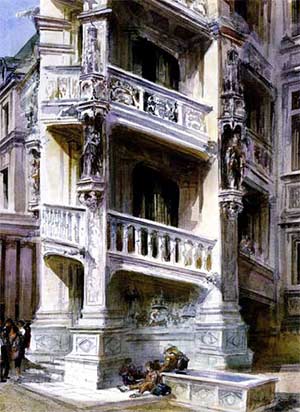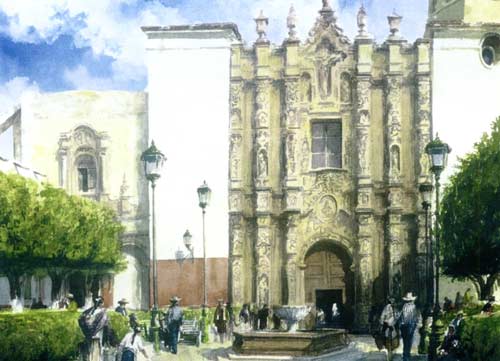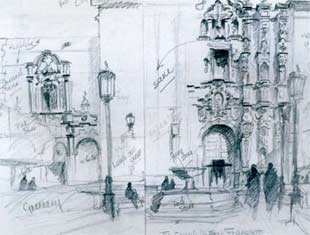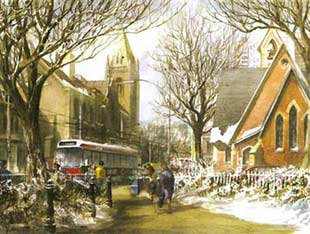Magazin d’Art
From the magazine: Magazin d’Art (International Magazine) Autumn/Fall 2009, no 85
PAINTING THE BUILT ENVIRONMENT by Noel Meyer
Anthony J. Batten has spent much of his artistic life painting the built environment, first in watercolours, then in oils and now in acrylics. For most of his working life he taught art history and then as his reputation as an artist became established he also started giving workshops.
He has painted the boulevards of Paris and the canals of Venice as well as street scenes in Turkey, Britain, Belgium, Germany, Canada, Italy and Greece and icebergs and marinescapes in the Arctic, to say nothing of the older parts of Ontario, Cape Cod, and Quebec.
A past president of the Canadian Society of Painters in Watercolour, CSPWC, once described Batten as “one of the few modern interpreters of the 18th and 19th century traditions of travelling artist.”

The Renaissance Stair Tower, Chateau of Bois, France. 30″ x 22″ watercolour
“If I go anywhere I always drop in on a building. I love gothic revival buildings like the Library of Parliament. I just love built space. I would have loved to create that stuff.”
Along the way he has served as the president of the CSPWC and had its juried Jubilee Collection exhibited in London and accepted into the Royal Collection in 1985, taught at the Canadian School in Cambridge for two years and exhibited on four continents.
He has also worked for C.B.C. as a demonstrating artist and designed and painted theatre sets. This is a somewhat bald account of his achievements.
Batten’s career may be described as one which has been affected by more than a little serendipity. He is largely self-taught, except that he did study under Arthur Lismer at the Montreal Museum of Fine Arts Museum School. He also attended the École des Beaux Arts in Montréal and Sir George Williams but mostly he studied art history and tool a teaching degree at the University of Toronto. He also once interviewed at the architecture school at McGill only to be told as he explained his passion for old buildings, “We are no longer building Gothic cathedrals.”
It is almost as if realizing that he couldn’t build them Batten then set out to memorialize them in paint. “My style is quite traditional, loose realism. Someone once kindly described it as romantic realism but it is very traditional work. The stuff I like doing is generally centered on some kind of architectural element. I’m working on one at the moment, the interior of a Baroque church in Munich.”
Any audience can connect with Batten’s work because his themes are all ones that we have seen, the streets of our own older neighbourhoods and the streets and monuments of those abroad. Batten’s natural inclination for the built environment and his interest in art married when C.I.L., where his father worked as an engineer, commissioned him to execute first a series of drawings of buildings in Old Montréal and then a map of the district during the mid 1960’s.
It was a time when the area was derelict. “It was a case of just drawing the buildings and then someone said why don’t you put some colour in and I started using watercolours and then a lovely gentlemen saw me sketching one day and he gave me my first show at the Galerie Place Royale.” In 1968 Batten moved to Toronto to study and remained there to teach at the high school and eventually the university level. In 1998 he retired from teaching to devote himself to painting.
He describes his transition to full time artist as both liberating and seamless. “It was wonderful. I didn’t miss teaching at all” Over the years he joined a number of artists’ organizations and taken part in numerous group and society shows. These connections had in turn produced invitations to exhibit in galleries but at the time he didn’t feel that he had enough paintings for a big show. Now he has gallery representation for both his watercolours and acrylics.

Church of San Franceco, San Miguel de Allende, Mexico. 22″ x 30″ watercolour
Batten’s palette fluctuates according to where he is. Travel still plays a large part of his plans. “I’m lucky, I have a partner who works for Air Canada.” This summer he had already traveled to Italy twice for long painting weekends and was on his way to the Maritimes and Gaspe for a week with a group of artists when he was interviewed.

Church of San Franceco. Pencil sketch
He produces roughly 60 works a year, more or less evenly divided between acrylics and watercolours. He is known for his mastery of light and texture. “I think light and texture are what painting is all about.”
“I used to work in oils but my studio is in my apartment and there is the smell and the drying time. I am now really happy working in acrylics. For years I hated them, the bright bright colours. The early acrylics were really harsh colours and I think to some extent because I was a self-taught artist, I wasn’t very comfortable experimenting with them. And also, the galleries weren’t very accepting of them 30 years ago.”
“I just like the fact that I can work on them at home and then when I am on the road I paint in watercolours all the time. Increasingly I am working in acrylics. I just love the fact you can correct all your errors, which can be many.” Batten, like many other watercolour artists, is frustrated by the way his preferred medium is seen. “The other thing is the public response. Because they are on canvas the public tends to see oils and acrylics as real paintings and it’s frustrating. Right now the watercolour market is pretty dead. Also, decorators don’t want glass.”

Early Snowfall. 22″ x 30″ watercolour
Sometimes Batten’s choice of medium will be dictated by the size he sees the finished work in. “If it’s a subject I want to work really large it will be acrylics. It’s so hard to get paper in large sizes and just sometimes I don’t want to see the image under glass.” For Batten, each medium feeds off the other. “Sometimes I do it in acrylics and get the effects I want and then learning from that I will sometimes do it in watercolours because I have already planned out all the shade and light pieces.” His watercolours are masterworks capturing as they do light, texture, shade, and shape and his acrylics look remarkably like his watercolours.
Batten has written several books about painting and for a time worked doing architectural renderings. He also led a number of workshops. While the recession put an end to his practice in architectural renderings, he deliberately decided to put a stop to the workshops because he wanted more time to paint. And that, judging by the work, was a good decision.
Read article in French. Download 1 MB, 5 page PDF file
